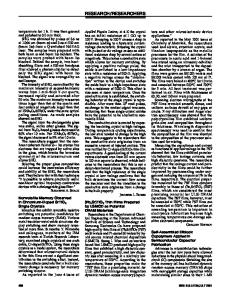SrTiO 3 Single Crystals Achieve 8% Plastic Strain When Tested in Compression at Room Temperature
- PDF / 56,430 Bytes
- 2 Pages / 612 x 792 pts (letter) Page_size
- 33 Downloads / 369 Views
ciency of these organic PV cells, the researchers found “that materials choice is an important route to cell optimization.” Hence, not only has efficiency been improved, but also the understanding of these devices. PAMELA JOHNSON
The Femtosecond Transient Absorption Signal of UV-Grade Fused Silica Contains Third- and Fifth-Order Nonlinearities Femtosecond transient absorption pump-probe spectroscopy and numerical simulations show interference between the third- and fifth-order nonlinear susceptibilities (χ(3), χ(5)) of ultraviolet (UV)grade fused silica. Katrin Ekvall of the Royal Institute of Technology in Stockholm and Cecilia Lundevall and Peter van der Meulen of Stockholm University have obtained values for the second-order nonlinear refractive index and the three-photon absorption (3 PA) coefficient from χ(5). As reported in the June 15 issue of Optics Letters, a compact Ti:sapphire amplified fs laser system produced ~850 µJ, 160 fs pulses centered at 775 nm. A 0.2-mm-thick Type I β-barium borate second-harmonic generation crystal frequency doubled the fundamental pulse to produce a pump pulse with λ = 387.5 nm. White light continuum probe and reference pulses were obtained by focusing a small fraction of the fundamental pulse in a thin rotating fused-silica plate. Both the third- and fifth-order material responses produce large signals in the detected region. The intensity of the pump pulse was varied from 90 to 160, 210, and 270 GW/cm2 by rotating a zero-order halfwave plate in front of the β-barium borate crystal. At the lowest intensity, the transient absorption signal was W-shaped. At higher intensities the curve developed an extra dip and the signal increased. The researchers describe the signal as a superposition of three contributions: the real part of χ(3), dominant at the lowest intensity; a similarly shaped effect with opposite sign from the real part of χ(5), which produces the dip at higher intensities; and the imaginary part of χ (5), corresponding to 3 PA. The researchers numerically solved the probe propagation equation in the presence of third- and fifth-order nonlinearities, obtaining the probe amplitude after propagation through the sample. They calculated the pump-probe signal as a function of probe wavelength and the delay time between the pump and the probe. 500
A comparison with the experiment gave the real and imaginary parts of χ(5). The real part is -5.1(±0.7) × 10-41 m4/V4, which gives for the second order nonlinear refractive index -3.3(±0.4) × 10-41 m4/V4. The error is due to the uncertainty in pump intensity. The imaginary part of χ(5) is 2.1(±0.3) × 10-41 m4/V4, which gives for the 3 PA coefficient 5.2(±0.7) × 10-29 m3/W2. The simulations did not accurately reproduce the measurements at the highest optical pump intensity, indicating the possibility that even higher order processes may play a role in the nonlinear optical response of this glass. ELIZABETH A. SHACK
Photopatterned Films of Discotic Liquid Crystals Demonstrate Polarized Photoluminescence The ability to control the
Data Loading...











